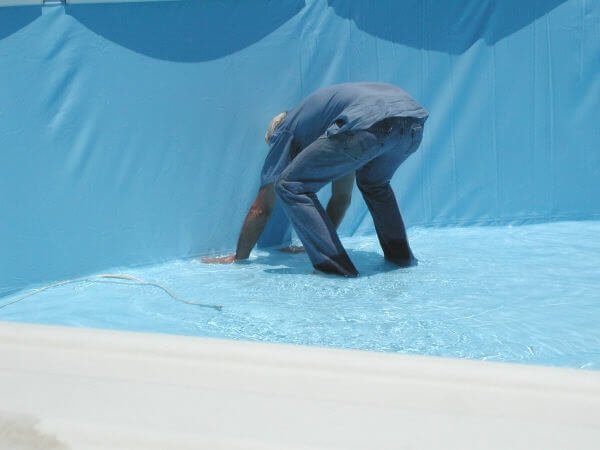Holes in Vinyl Pool
Finding and Repairing
Finding holes in vinyl pools can be a real pain if you have no clue where to look. Repairing the hole is usually the easiest part, it's just finding the thing that's hard.
Most of the time holes in vinyl pools are located around the outer edge. At least the ones that will create significant water loss. There are two reasons for this. The outer pool edge gets the most abuse from vacuums and cleaners. At or near the cove area of the pool the water is usually free to flow out of the pool with little restriction. A hole in the center of the pool will leak much slower because the water will normally have a much tougher time becoming absorbed into the soil.

If the damp spot is around the filter you should first eliminate that as a possibility. Check all of the fittings and connections with the filter running and with the filter off. The pressure side will leak with the filter running and the suction side when the filter is off. Read more about filter system leaks.
I usually use goggles and search for holes with the pools full of water. I dive down and rub my hand over an area of liner. All of the dirt and debris will move when I do this. A hole looks like a piece of dirt so anything that does not move needs a closer inspection. Do this at the top of the cove area and you will usually find your hole.
If you need to drain the pool to do this always keep at least a foot of water in it. A vinyl liner will shrink if left completely empty.
Once the hole is located simply cut a round
circle out of the patch material that came with your patch kit.
There is only one vinyl glue I use and have for over 40 years.
Boxer - 4 oz Vinyl Swimming Pool Liner Repair Kit![]() (#ad)
Make the patch about twice the size of the hole. Apply the
glue out of water, fold the patch over to hold the glue in place,
take the patch to the hole and hold in place for a few seconds.
When patching under water I then come up for air and stick my big
toe over the patch for a minute or two.
(#ad)
Make the patch about twice the size of the hole. Apply the
glue out of water, fold the patch over to hold the glue in place,
take the patch to the hole and hold in place for a few seconds.
When patching under water I then come up for air and stick my big
toe over the patch for a minute or two.
With the popularity of automatic pool cleaners it is now possible to have little pin holes all over a section of the liner. Pin holes can be nearly impossible to find. Getting under the liner looking for light coming through the holes can sometimes be the only way. Never replace a liner without knowing why it was leaking, spend some time in the dark, under the liner, and see if there is something you can do different to make the new liner last longer. It is usually a simple matter of using the cleaner less often and always making sure it stays in motion. A cleaner that gets stuck in one spot, every time it runs, is usually the cause of pin holes.
I hear this all the time, "I let the pool leak down until it stopped leaking thinking this would be the place where the hole is. It is about half full and seems to have stopped leaking but I cannot find anything on the sides of the pool". There is a reason for this. The less water in the pool the less pressure there is pushing down on the holes. As the water lowers so does the amount of pressure and the holes tend to seal themselves up. It is very uncommon to have a hole on the side of the pool.
If you have a question feel free to ask the pool pro.